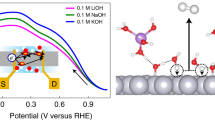Abstract
We propose a method for the computation of changes in pHS of an electrolyte near the electrode in the cathodic reduction of dissolved oxygen. We show that, in the course of oxygen reduction with the limiting current in relatively acidic aqueous solutions (pH0 3), an abrupt increase in pHS (by 5–8 pH units) is possible. We describe the influence of a base electrolyte (KCl) and the thickness of the diffusion layer on the degree of alkalization of the electrolyte. In addition, we discuss the possible ways of practical application of the developed method.
Similar content being viewed by others
REFERENCES
K. J. Vetter, Elektrochemische Kinetik, Springer, Berlin (1961).
V. S. Kublanovskii, A. V. Gorodyskii, V. N. Belinskii, and T. S. Glushchak, Concentration Changes in Near-Electrode Layers in the Course of Electrolysis [in Russian], Naukova Dumka, Kiev (1978).
D. A. Tkalenko, Macrokinetics of Cathodic Processes in Hydroxide and Nitrate Melts [in Russian], Naukova Dumka, Kiev (1993).
V. S. Kublanovskii, A. V. Gorodyskii, and V. V. Pototskaya, “Calculation of the alkalization of the near-cathode layer in water electrolysis,” Zh. Fiz. Khim., 47, No. 2, 452-454 (1973).
M. D. Tkalenko, S. A. Mazanko, A. V. Protsenko, and D. A. Tkalenko, “Macrokinetic approach to the analysis of the action of corrosion inhibitors,” in: Proc. 3rd Int. Conf. “Problems of Corrosion and Rust Protection of Structural Materials” [in Ukrainian] (Lviv, May 28-30, 1996), pp. 222-224.
D. A. Tkalenko, N. A. Chmilenko, and M. D. Tkalenko, “Application of the superposition principle for evaluating the state of the surface of metals in aqueous solutions,” Dokl. Nats. Akad. Nauk Ukrainy, No. 6, 118-120 (1996).
M. D. Tkalenko, Concentration Changes in the Near-Electrode Layer of an Electrolyte and Their Influence on the Parameters of Electrochemical Systems [in Russian], Candidate Degree Thesis (Chemistry), Nat. Tech. Univ. of Ukraine “KPI,” Kiev (2000).
M. R. Tarasevich and E. I. Khrushcheva, “Mechanism and kinetics of oxygen electroreduction on metallic electrodes,” in: Advances in Science and Technology, Electrochemistry [in Russian], Vol. 17, VINITI, Moscow (1981), pp. 42-85.
S. Peulon and D. Lincot, “Mechanistic study of cathodic electrodeposition of zinc oxide and zinc hydroxychloride film from oxygenated aqueous zinc chloride solutions,” J. Electrochem. Soc., 145, No. 3, 864-874 (1998).
I. A. Kukushkina, G. V. Zhutaeva, G. V. Shteinberg, and V. S. Bagotskii, “Ionization of oxygen on silver in concentrated alkaline solutions,” Élektrokhimiya, 12, No. 1, 38-42 (1976).
L. I. Antropov, Theoretical Electrochemistry [in Russian], Vysshaya Shkola, Moscow (1975).
Rights and permissions
About this article
Cite this article
Tkalenko, M.D., Tkalenko, D.A. & Kublanovs'kyi, V.S. Change in the pH of Solutions and the Cathodic Passivation of Metals under the Conditions of Electrochemical Protection in Aqueous Media. Materials Science 38, 394–398 (2002). https://doi.org/10.1023/A:1021777817858
Issue Date:
DOI: https://doi.org/10.1023/A:1021777817858




